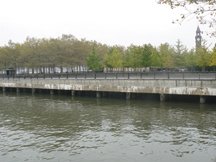As thousands of visitors flock to Hoboken’s waterfront on July 4 for views of the Macy’s fireworks over the Hudson River, the city is still dealing with concerns about certain waterfront areas and the pilings that support them after a January report indicated the city needs to perform major repairs.
The collapse of a one-block section of Sinatra Drive North uptown in October 2010 was the impetus for a city-wide waterfront inspection.
Sinatra Drive North was built on timber pilings, which are susceptible to damage from sea creatures known as shipworms. The small, water-based creatures burrow into submerged wood, leaving structures riddled with holes. Individual shipworms can live between one and three years, and can survive for up to six weeks sealed in the wood.
Sinatra Drive North is expected to re-open to traffic in the middle of August.
____________
Part of the pier at Castle Point gave way in 2007. Sinatra Park has been closed since 2009, when a corner of the soccer field collapsed.
Boswell was hired by the City Council last November to complete a waterfront inspection, which included properties public and private, for $334,395. In January, Boswell Engineering issued a report that showed that the city-owned properties along the waterfront need repair.
The council has issued bonds raising $12 million to repair Castle Point and Sinatra Field, but the recommendations in the report were for a total of $20 million.
Mayor Dawn Zimmer, who said she was “surprised” by the January report, said on Thursday that the city was able to secure $2.4 million in government funding for the waterfront park projects, combining $1.5 million from the Hudson County Open Space Fund and $900,000 from the DEP’s Green Acres program.
“As soon as we get the approval, we’ll move through it,” Zimmer said.
Update on Pier A Park, private properties
The January report indicated that the city’s downtown Pier A Park, only 10 years old, is in need of $3.6 million in repairs to the underwater pilings that hold up the park. Those repairs have not yet begun.
The city is trying to secure bond counsel, an attorney or law firm that can help with issuing a municipal bond to finance the repairs.
Pomante said the work at Pier A Park is “not an urgent situation.”
“But it needs to be repaired on a maintenance type basis,” Pomante said.
Zimmer reassured the public in January that Pier A Park was “fully safe.”
The contract for the repairs will either be awarded to Boswell or be put out to bid by the City Council.
Councilwoman Beth Mason called for the establishment of an ad-hoc subcommittee on the waterfront in November. She said last week she hasn’t been updated regularly about the repairs.
In addition to reviewing public properties along the waterfront, Boswell also conducted a review of private properties. Pomante said he expects that report to be released within the next few weeks.
The January report said the condition of the private properties generally varied from “fair to poor.”
Pomante added that the waterfront repairs take time, mostly because they will require the city to make changes “designed for the long term.”
Roads were previously built on timber pilings, but new projects will be built on steel or concrete pilings, which are less susceptible to deterioration.
“There’s a lot of painstaking work that goes into the design,” Pomante said. “It’s a tough process, but I believe we’re working through it well.”
Sinatra Drive North update
County spokesperson Jim Kennelly said on Thursday that Sinatra Drive North is expected to be open to traffic again in the middle of August. While the opening was originally predicted for the end of May, stormy winter and the need for more work below the road contributed to some delays, he said.
The collapse occurred on Oct. 8, caused by deterioration of the timber pilings that hold the road above the water. The cost has been picked up by the county because Sinatra Drive North is a county-owned road.
The Hudson County Board of Freeholders voted on Jan. 13 to approve a $2.1 million contract to Sparwick Contracting of Lafayette, N.J. for the repair of the road.
Kennelly said engineers have driven additional pilings into the river bottom to support the relieving platform, which will hold the new road, and that delayed the construction. He said engineers are also adding “rock anchors” which stabilize the pilings in case of a major seismic event.
The county faces another hurdle before the road is finished: Making sure the new road matches up to the surrounding walkways. The waterfront walkway, which is still standing, belongs to Applied Housing, the developer of nearby apartment buildings. Whenever a new waterfront development is built, the developer must also construct part of the walkway on the Hudson River, by state law.
Ray Smith may be reached at RSmith@hudsonreporter.com
